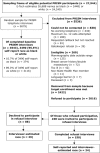Triangulating differential nonresponse by race in a telephone survey
- PMID: 17572964
- PMCID: PMC1955404
Triangulating differential nonresponse by race in a telephone survey
Abstract
Introduction: In 1994, the U.S. Department of Health and Human Services mandated sufficient inclusion of racial and ethnic minorities in all federally funded research. This mandate requires researchers to monitor study samples for research participation and differential survey nonresponse. This study illustrates methods to assess differential survey nonresponse when population race data are incomplete, which is often the case when studies are conducted among members of health plans.
Methods: We collected data as part of the PRISM (Personally Relevant Information about Screening Mammography) study, a trial funded by the National Institutes of Health to increase rates of annual mammography adherence. We used two methods to estimate racial distribution of the PRISM study population. The first method, called E-Tech, estimated race of the sample frame by using individuals' names and zip codes. In the second method, we conducted interviews with a subsample of PRISM study refusals. We validated both estimation methods through comparisons with self-reported race. We used race information generated by E-Tech, interviewer estimates, and self-report to assess differential nonresponse in the PRISM study.
Results: The E-Tech method had moderate sensitivity (48%) in estimating race of black participants but higher specificity (97%) and positive predictive value (71%). The interviewer-estimation method had high sensitivity (100%), high specificity (95%), and moderate positive predictive value (80%). Black women were less likely than white women to be reached for study participation.
Conclusion: There was slight differential nonresponse by race in the PRISM study. Techniques described here may be useful for assessing differential nonresponse in samples with incomplete data on race.
Figures
References
-
- Lessler JT, Kalsbeek WD. Nonsampling error in surveys. New York (NY): John Wiley & Sons; 1992.
-
- Jones J. The effects of non-response on statistical inference. J Health Soc Policy. 1996;8(1):49–62. - PubMed
-
- Partin MR, Malone M, Winnett M, Slater J, Bar-Cohen A, Caplan L. The impact of survey nonresponse bias on conclusions drawn from a mammography intervention trial. J Clin Epidemiol. 2003 Sep;56(9):867–873. - PubMed


